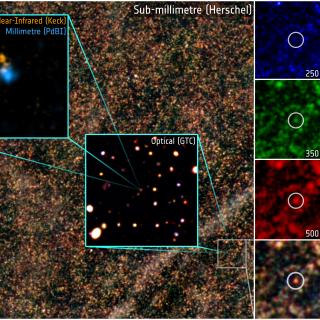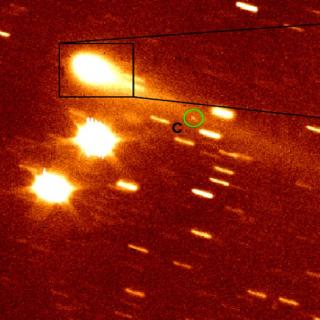Bibcode
Licandro, J.; de León, J.; Moreno, F.; de la Fuente Marcos, C.; de la Fuente Marcos, R.; Cabrera-Lavers, A.; Lara, L.; de Souza-Feliciano, A.; De Prá, M.; Pinilla-Alonso, N.; Geier, S.
Referencia bibliográfica
Astronomy and Astrophysics
Fecha de publicación:
6
2021
Revista
Número de citas
6
Número de citas referidas
5
Descripción
Context. The existence of comets with heliocentric orbital periods close to that of Jupiter (i.e., co-orbitals) has been known for some time. Comet 295P/LINEAR (2002 AR2) is a well-known quasi-satellite of Jupiter. However, their orbits are not long-term stable, and they may eventually experience flybys with Jupiter at very close range, close enough to trigger tidal disruptions like the one suffered by comet Shoemaker-Levy 9 in 1992.
Aims: Our aim was to study the observed activity and the dynamical evolution of the Jupiter transient co-orbital comet P/2019 LD2 (ATLAS) and its dynamical evolution.
Methods: We present results of an observational study of P/2019 LD2 carried out with the 10.4 m Gran Telescopio Canarias (GTC) that includes image analyses using a Monte Carlo dust tail fitting code to characterize its level of cometary activity, and spectroscopic studies to search for gas emission. We also present N-body simulations to explore its past, present, and future orbital evolution.
Results: Images of P/2019 LD2 obtained on May 16, 2020, show a conspicuous coma and tail, but the spectrum obtained on May 17, 2020, does not exhibit any evidence of CN, C2, or C3 emission. The comet brightness in a 2.6'' aperture diameter is r' = 19.34 ± 0.02 mag, with colors (g'− r') = 0.78 ± 0.03, (r'− i') = 0.31 ± 0.03, and (i'− z') = 0.26 ± 0.03. The temporal dependence of the dust loss rate of P/2019 LD2 can be parameterized by a Gaussian function having a full width at half maximum of 350 days, with a maximum dust mass loss rate of 60 kg s−1 reached on August 15, 2019. The total dust loss rate from the beginning of activity until the GTC observation date (May 16, 2020) is estimated at 1.9 × 109 kg. Comet P/2019 LD2 is now an ephemeral co-orbital of Jupiter, following what looks like a short arc of a quasi-satellite cycle that started in 2017 and will end in 2028. On January 23, 2063, it will experience a very close encounter with Jupiter at perhaps 0.016 au; its probability of escaping the solar system during the next 0.5 Myr is estimated to be 0.53 ± 0.03.
Conclusions: Photometry and tail model results show that P/2019 LD2 is a kilometer-sized object, in the size range of the Jupiter-family comets, with a typical comet-like activity most likely linked to sublimation of crystalline water ice and clathrates. Its origin is still an open question. Our numerical studies give a probability of this comet having been captured from interstellar space during the last 0.5 Myr of 0.49 ± 0.02 (average and standard deviation), 0.67 ± 0.06 during the last 1 Myr, 0.83 ± 0.06 over 3 Myr, and 0.91 ± 0.09 during the last 5 Myr.
Aims: Our aim was to study the observed activity and the dynamical evolution of the Jupiter transient co-orbital comet P/2019 LD2 (ATLAS) and its dynamical evolution.
Methods: We present results of an observational study of P/2019 LD2 carried out with the 10.4 m Gran Telescopio Canarias (GTC) that includes image analyses using a Monte Carlo dust tail fitting code to characterize its level of cometary activity, and spectroscopic studies to search for gas emission. We also present N-body simulations to explore its past, present, and future orbital evolution.
Results: Images of P/2019 LD2 obtained on May 16, 2020, show a conspicuous coma and tail, but the spectrum obtained on May 17, 2020, does not exhibit any evidence of CN, C2, or C3 emission. The comet brightness in a 2.6'' aperture diameter is r' = 19.34 ± 0.02 mag, with colors (g'− r') = 0.78 ± 0.03, (r'− i') = 0.31 ± 0.03, and (i'− z') = 0.26 ± 0.03. The temporal dependence of the dust loss rate of P/2019 LD2 can be parameterized by a Gaussian function having a full width at half maximum of 350 days, with a maximum dust mass loss rate of 60 kg s−1 reached on August 15, 2019. The total dust loss rate from the beginning of activity until the GTC observation date (May 16, 2020) is estimated at 1.9 × 109 kg. Comet P/2019 LD2 is now an ephemeral co-orbital of Jupiter, following what looks like a short arc of a quasi-satellite cycle that started in 2017 and will end in 2028. On January 23, 2063, it will experience a very close encounter with Jupiter at perhaps 0.016 au; its probability of escaping the solar system during the next 0.5 Myr is estimated to be 0.53 ± 0.03.
Conclusions: Photometry and tail model results show that P/2019 LD2 is a kilometer-sized object, in the size range of the Jupiter-family comets, with a typical comet-like activity most likely linked to sublimation of crystalline water ice and clathrates. Its origin is still an open question. Our numerical studies give a probability of this comet having been captured from interstellar space during the last 0.5 Myr of 0.49 ± 0.02 (average and standard deviation), 0.67 ± 0.06 during the last 1 Myr, 0.83 ± 0.06 over 3 Myr, and 0.91 ± 0.09 during the last 5 Myr.
Based on observations made with the GTC telescope, in the Spanish Observatorio del Roque de los Muchachos of the Instituto de Astrofísica de Canarias (program ID GTCMULTIPLE2F-20A).
Proyectos relacionados

Formación y Evolución de Galaxias: Observaciones Infrarrojas y en otras Longitudes de Onda
Este grupo desarrolla varios proyectos extragalácticos en diferentes rangos del espectro electromagnético utilizando satélites y telescopios en tierra para estudiar la evolución cosmológica de las galaxias y el origen de la actividad nuclear en galaxias activas. En el aspecto instrumental, el grupo forma parte del consorcio internacional que ha
Ismael
Pérez Fournon

Pequeños Cuerpos del Sistema Solar
Este Proyecto estudia las propiedades físicas y composicionales de los llamados pequeños cuerpos del Sistema Solar, que incluyen asteroides, objetos helados y cometas. Entre los grupos de mayor interés destacan los objetos trans-neptunianos (TNOs), incluyendo los objetos más lejanos detectados hasta la fecha (Extreme-TNOs o ETNOs); los cometas, y
Julia de
León Cruz